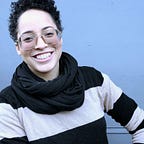Noise Pollution
My boyfriend and I live on Northwest Naito Parkway in Portland OR. The map shown below is the street on which I live. The darker red, orange, and yellow map (left) is Traffic Proximity, and the lighter map (right) is the Low-Income Population National Percentiles. According to the EPA, I live in the 80–90th percentile of traffic proximity with nearly 1200 vehicles driving by my apartment complex daily. Simply, we live on a busy street. Additionally, the apartment complex is aptly named after its neighbor, the Portland Union Station. At regular intervals throughout the day, more often due to COVID-19, the train will blare its ungodly horn. Under the Train Horn Rule, locomotive engineers must blare the train horn for 15–20 seconds in advance of all public-grade crossings (Federal Railroad Administration, 2020). Trust me when I say, 20 seconds can sound like an hour at 2 AM.
Noise pollution is profoundly serious. According to Environmental Pollution Centers, noise pollution is defined as “regular exposure to elevated sound levels that may lead to adverse effects in humans or other living organisms” (Environmental Pollution Centers, 2021). Noise pollution is ever-present, an invisible danger that leads to auditory and non-auditory adverse health conditions, such as hypertension, sleep disturbances, and dementia. Noise pollution can impact children’s development, making them more sensitive to noise, and create psychological dysfunction. The most common health problem is Noise Induced Hearing Loss (NIHL) (National Geographic Society, 2019). Prolonged exposure can alter the structure of the hair cells in the inner ear resulting in hearing loss and cause tinnitus, the ringing, roaring, buzzing, or clicking in the ears (Chepesiuk, 2005). The US Environmental Protection Agency (EPA) has identified transportation — passenger vehicles, trains, buses, motorcycles, medium and heavy trucks, and aircrafts — as one of the most pervasive outdoor noise sources, estimating that more than 100 million people in the United States are exposed to noise sources from traffic near their homes (US Environmental Protection Agency, 1981).
There is increasing use of the of the phrase secondhand noise, which describes noise that is experienced by people who did not produce it, its effects like that of secondhand smoking (Chepesiuk, 2005). Anti-noise activists Les Blomberg, Executive Director of the Noise Pollution Clearinghouse states that, “secondhand noise is a civil rights issue […] it is put into the environment without people’s consent and then has effects on them that they don’t have any control over.” According to the WHO Guidelines for Community Noise, the health effects because of noise pollution are social handicaps causing “reduced productivity, decreased performance in learning, absenteeism in the workplace and school, increased drug use, and accidents” (Berglund et al.)
The Environmental Pollution Centers advise the public to wear earplugs and avoid prolonged use of earphones, especially at elevated sound levels (Environmental Pollution Centers, 2021). If possible, avoid occupations with regular exposure to elevated sounds and choose residential areas that are far removed from heavy traffic. But as the right-side map indicates, there is a higher concentration of low-income individuals in my area and relocation is not a feasible option, despite mounting health risks from the environment. Please check out this article about how urban noise is worst in poor and minority neighborhoods and segregated cities.
For more information on Noise Pollution and your health, here is an interesting TED Talk.
Berglund, B., Lindvall, T., & Schwela, D. H. (n.d.). GUIDELINES FOR COMMUNITY NOISE.
Chepesiuk, R. (2005). Decibel hell. In Environmental Health Perspectives (Vol. 113, Issue 1, p. A34). Public Health Services, US Dept of Health and Human Services. https://doi.org/10.1289/ehp.113-a34
Environmental Pollution Centers. (2021). Noise Pollution. https://www.environmentalpollutioncenters.org/noise-pollution/
Federal Railroad Administration. (2020, January 2). The Train Horn Rule and Quiet Zones . U.S. Department of Transportation. https://railroads.dot.gov/highway-rail-crossing-and-trespasser-programs/train-horn-rulequiet-zones/train-horn-rule-and-quiet
National Geographic Society. (2019, July 16). Noise Pollution. https://www.nationalgeographic.org/encyclopedia/noise-pollution/ US
Environmental Protection Agency. (1981). Noise Effects Handbooks: A Desk Reference to Health and Welfare Effects of Noise. https://nepis.epa.gov/Exe/ZyPURL.cgi?Dockey=9100OOAJ.txt
